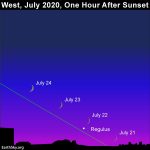
Joseph Campbell wrote in his book “The Power of Myth“:
The power of life causes the snake to shed its skin, just as the moon sheds its shadow.
What did he mean by the moon shedding its shadow? For all worlds including the Earth and moon, night is a shadow. That is, when night falls on Earth, you’re standing within Earth’s shadow. Likewise, when you see a crescent moon in the evening sky – such as the one you’ll see on the evenings of July 21 to 24 – you’re looking at a slim fraction of moon’s dayside, and a larger fraction of its nightside. That nightside on the moon is its own shadow. Over those evenings, watch for the young moon to shed its shadow as seen from our earthly perspective – to show us more of its dayside and less of its nightside – as the moon grows in radiance in our sky.
The moon turned new on July 20, 2020. At that point, its shadowed side, or night side, faced Earth entirely, and the moon traveled across the sky with the sun during the day. The moon is said to be reborn – and a new lunation, or lunar cycle, is said to begin – at new moon. After new moon, the moon returns as a crescent to the evening sky. When the newly born moon makes its initial appearance in the west after sunset July 21, 2020, only the slightest sliver of sunlight will be lighting up the far edge of the moon as seen from Earth.
It’ll be easy to miss the moon after sunset July 21. For most of the world, the pale, whisker-thin lunar crescent will follow the sun beneath the horizon before nightfall (or before the end of astronomical twilight). If you’re up for the challenge, try catching the young moon with either the unaided eye or binoculars.
Day by the day, a wider and brighter crescent will appear higher up at sunset, and will stay out longer after dark.
You might also see Regulus, the brightest star in the constellation Leo the Lion, sometimes called the Lion’s Heart. This star is now heading into the sunset for another season. If you can’t see bright Regulus so near the glow of evening twilight, try sweeping with your binoculars. The moon will be closest to Regulus from our North America perspective on July 22. For your own unique perspective from your part of the world, try Stellarium-Web.
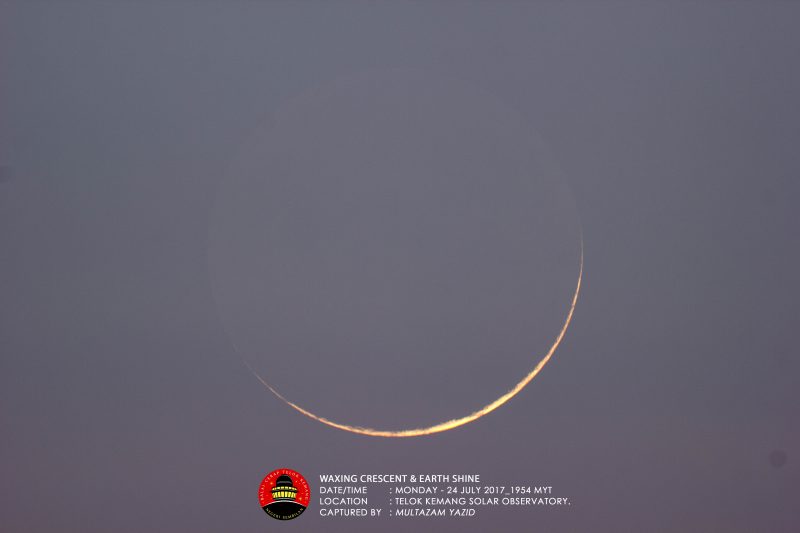
Multazam Yazid captured the extremely young waxing moon on July 24, 2017, from Telok Kemang Observatory, Port Dickson, Malaysia. He was using a Takahashi TOA-150 telescope and a DSLR Canon 550D.
While you’re at it, enjoy the entrancing beauty of earthshine softly illuminating the nighttime side of the moon. Earthshine, which is most readily visible at the moon’s crescent phase, counts as twice-reflected sunlight, with sunlight bouncing from Earth to the moon, and then from the moon back to Earth. You know how, when it’s full moon, we on Earth see moonlight lighting up our earthly landscape? When we see a crescent moon, anyone on the moon would see a nearly full Earth. Earthlight illuminates the lunar landscape just as moonlight from a full or nearly full moon lights up our landscape.
That’s what you’re seeing when you see earthshine on a crescent moon.
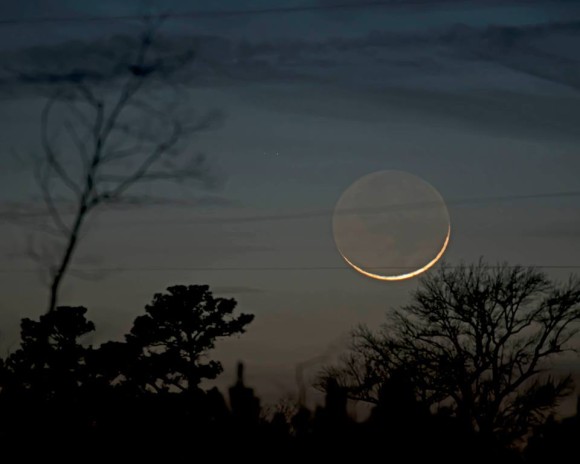
Ken Christison caught a very young moon, with its dark side all aglow in earthshine, on March 31, 2014, the day after a new moon.
In space, the moon is actually always half-lit by the sun and half-covered by its own shadow. The portion of the moon’s day side or night side that’s visible from Earth depends on the ever-changing position of the moon, relative to the sun and Earth. At new moon – when the moon swings in between the Earth and sun – the moon’s nighttime side totally faces Earth; at full moon – when the moon is opposite the sun in Earth’s sky – the moon’s daytime side totally faces Earth.
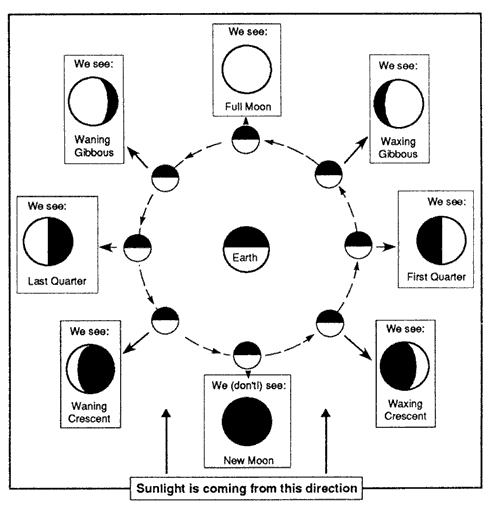
A bird’s-eye view of the north side of the moon’s orbital plane finds the moon circling Earth in a counterclockwise direction. At new moon, when the moon is between the Earth and sun, the moon’s nighttime side totally faces Earth. At full moon, when the moon is opposite the sun in our sky, the moon’s daytime side totally faces Earth.
When the moon, Earth and sun make a 90 degree or right angle in space – with Earth at the vertex of this angle – then it’s either a first quarter or last quarter moon. At quarter moon, the eye perceives the moon as half-illuminated in sunshine and half-covered in the moon’s own shadow.
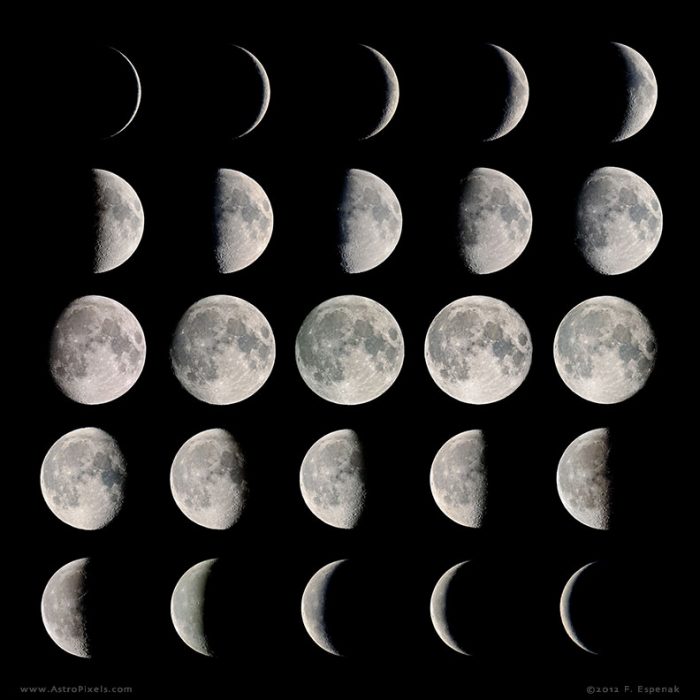
As the moon orbits Earth, its changing geometry with respect to the sun produces the characteristic phases. This composite image is a mosaic made from 25 individual photos of the moon and illustrates its phases over one synodic month. For complete details about this image, see Moon Phases Mosaic. Photo copyright Fred Espenak.
Because the moon moves eastward (away from the setting sun) at the rate of about 12 degrees per day, watch for the young moon to shed its shadow as it waxes from new moon to full moon during the next two weeks.
Bottom line: Watch for the waxing crescent moon – what astronomers call a young moon – in the west after sunset on July 21 to 24, 2020.
from EarthSky https://ift.tt/2WGmTwC

Joseph Campbell wrote in his book “The Power of Myth“:
The power of life causes the snake to shed its skin, just as the moon sheds its shadow.
What did he mean by the moon shedding its shadow? For all worlds including the Earth and moon, night is a shadow. That is, when night falls on Earth, you’re standing within Earth’s shadow. Likewise, when you see a crescent moon in the evening sky – such as the one you’ll see on the evenings of July 21 to 24 – you’re looking at a slim fraction of moon’s dayside, and a larger fraction of its nightside. That nightside on the moon is its own shadow. Over those evenings, watch for the young moon to shed its shadow as seen from our earthly perspective – to show us more of its dayside and less of its nightside – as the moon grows in radiance in our sky.
The moon turned new on July 20, 2020. At that point, its shadowed side, or night side, faced Earth entirely, and the moon traveled across the sky with the sun during the day. The moon is said to be reborn – and a new lunation, or lunar cycle, is said to begin – at new moon. After new moon, the moon returns as a crescent to the evening sky. When the newly born moon makes its initial appearance in the west after sunset July 21, 2020, only the slightest sliver of sunlight will be lighting up the far edge of the moon as seen from Earth.
It’ll be easy to miss the moon after sunset July 21. For most of the world, the pale, whisker-thin lunar crescent will follow the sun beneath the horizon before nightfall (or before the end of astronomical twilight). If you’re up for the challenge, try catching the young moon with either the unaided eye or binoculars.
Day by the day, a wider and brighter crescent will appear higher up at sunset, and will stay out longer after dark.
You might also see Regulus, the brightest star in the constellation Leo the Lion, sometimes called the Lion’s Heart. This star is now heading into the sunset for another season. If you can’t see bright Regulus so near the glow of evening twilight, try sweeping with your binoculars. The moon will be closest to Regulus from our North America perspective on July 22. For your own unique perspective from your part of the world, try Stellarium-Web.

Multazam Yazid captured the extremely young waxing moon on July 24, 2017, from Telok Kemang Observatory, Port Dickson, Malaysia. He was using a Takahashi TOA-150 telescope and a DSLR Canon 550D.
While you’re at it, enjoy the entrancing beauty of earthshine softly illuminating the nighttime side of the moon. Earthshine, which is most readily visible at the moon’s crescent phase, counts as twice-reflected sunlight, with sunlight bouncing from Earth to the moon, and then from the moon back to Earth. You know how, when it’s full moon, we on Earth see moonlight lighting up our earthly landscape? When we see a crescent moon, anyone on the moon would see a nearly full Earth. Earthlight illuminates the lunar landscape just as moonlight from a full or nearly full moon lights up our landscape.
That’s what you’re seeing when you see earthshine on a crescent moon.

Ken Christison caught a very young moon, with its dark side all aglow in earthshine, on March 31, 2014, the day after a new moon.
In space, the moon is actually always half-lit by the sun and half-covered by its own shadow. The portion of the moon’s day side or night side that’s visible from Earth depends on the ever-changing position of the moon, relative to the sun and Earth. At new moon – when the moon swings in between the Earth and sun – the moon’s nighttime side totally faces Earth; at full moon – when the moon is opposite the sun in Earth’s sky – the moon’s daytime side totally faces Earth.

A bird’s-eye view of the north side of the moon’s orbital plane finds the moon circling Earth in a counterclockwise direction. At new moon, when the moon is between the Earth and sun, the moon’s nighttime side totally faces Earth. At full moon, when the moon is opposite the sun in our sky, the moon’s daytime side totally faces Earth.
When the moon, Earth and sun make a 90 degree or right angle in space – with Earth at the vertex of this angle – then it’s either a first quarter or last quarter moon. At quarter moon, the eye perceives the moon as half-illuminated in sunshine and half-covered in the moon’s own shadow.

As the moon orbits Earth, its changing geometry with respect to the sun produces the characteristic phases. This composite image is a mosaic made from 25 individual photos of the moon and illustrates its phases over one synodic month. For complete details about this image, see Moon Phases Mosaic. Photo copyright Fred Espenak.
Because the moon moves eastward (away from the setting sun) at the rate of about 12 degrees per day, watch for the young moon to shed its shadow as it waxes from new moon to full moon during the next two weeks.
Bottom line: Watch for the waxing crescent moon – what astronomers call a young moon – in the west after sunset on July 21 to 24, 2020.
from EarthSky https://ift.tt/2WGmTwC

Aucun commentaire:
Enregistrer un commentaire